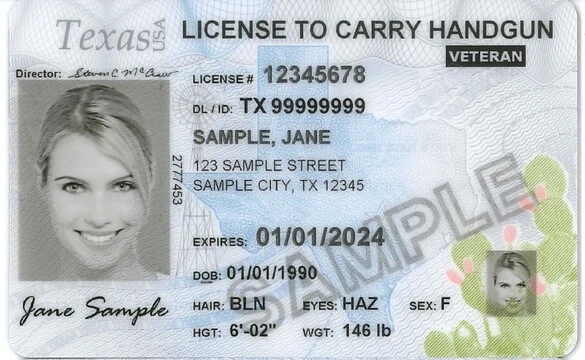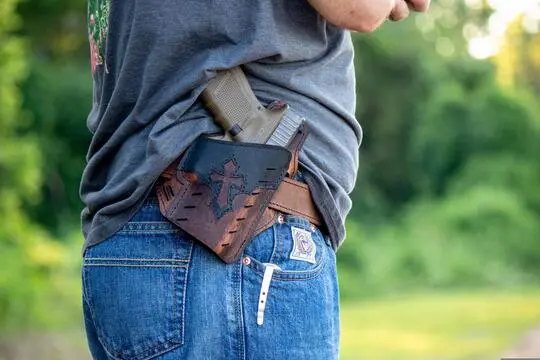Are you preparing to take the Texas LTC written test? Don't stress! Our study guide has got you covered. From firearm safety to Texas laws, we cover it all. Our guide provides you with clear explanations, visual aids, and practice questions to help you confidently pass the exam. With our help, you'll be on your way to obtaining your Texas LTC license in no time. Start studying today and feel confident on test day!
The written test is 25 true/false and multiple choice type questions. While I can't reproduce the exact questions and answers, the following 25 statements contain both.
Use this study guide to study for the test.
-
Business Alcohol Income and Handgun Prohibition
Businesses that derive 51 percent or more of their income from the sale of alcohol for on-premises consumption are designated areas where carrying a handgun is prohibited.
-
License Holder's Responsibility on Private Property
License holders are prohibited from carrying handguns on private property without effective consent if notice has been given under Penal Code §30.06 or §30.07.
-
Definition of 'Premises' Under Penal Code §46.03
The term 'premises' encompasses a building or a portion of a building, excluding any private driveways, streets, sidewalks, walkways, parking lots, parking garages, or other parking areas.
-
Reciprocity Agreement and State Laws Compliance
A Texas License to Carry (LTC) holder must comply with the laws of another state when carrying a handgun there under a reciprocity agreement.
-
Deadly Force Definition
Deadly force is defined as force that is intended or known by the actor to cause, or in the manner of its use is capable of causing, death or serious bodily injury.
-
Civil Lawsuits Post-Justified Use of Deadly Force
Even if the use of deadly force is justified in a criminal case, a civil lawsuit may still be filed against the license holder.
-
Prohibited Locations for Handguns
Handguns are prohibited in secured areas of airports, on the premises of polling places on election days, and on the premises of racetracks.
-
Criminal Prosecution for Unsecured Firearms Accessible to Children
Individuals may face criminal prosecution if a child gains access to a readily dischargeable firearm left in a place known to be accessible to the child.
-
Peace Officer's Authority to Disarm
A peace officer is authorized to disarm a license holder if the officer reasonably believes that someone's safety is at risk.
-
Definition of 'Intoxicated'
'Intoxicated' is defined as not having the normal use of mental or physical faculties due to the influence of alcohol, controlled substances, drugs, dangerous drugs, or a combination thereof, or having an alcohol concentration of .08 or more.
-
Conditions Where Retreat is Not Required
A person is not required to retreat if they have the right to be present at the location where force is used, have not provoked the person against whom force is used, and are not engaged in criminal activity at the time force is used.
-
Handgun Safety Principle
It's a fundamental safety rule to always treat a handgun as if it were loaded to prevent accidental discharge and ensure safety.
-
Handgun Maintenance Recommendations
Proper handgun maintenance includes keeping the handgun clean and lubricated. These measures are essential for ensuring the firearm's functionality and safety.
-
Best Practices for Handgun Storage
Handguns should be stored in a manner that is not accessible to unauthorized individuals, ensuring safety and security. This often involves securing the handgun in a safe or locked container.
-
Criteria for a Well Restrained Handgun
A well-restrained handgun will not fall from its holster during movement, is not easily removed by others, and remains readily accessible by the person carrying it.
-
Misconception About Hiding Loaded Guns
Hiding a loaded gun does not guarantee it will be inaccessible to children and is not the best method for preventing access.
-
Reliability of Handgun Safeties
The presence of a safety on a handgun does not guarantee that the firearm will not fire, emphasizing the importance of handling firearms responsibly.
-
Important Firearm Safety Rule
Keeping one's finger off the trigger until ready to shoot is an important safety rule to prevent accidental discharge.
-
Recommended Safety Gear for Shooting Practice
When practicing shooting, it is recommended to use eye protection, ear protection, and headwear to ensure safety.
-
Awareness in Shooting Environments
Knowing your target, backstop, and beyond is crucial for safe shooting practices to prevent accidents and ensure the safety of oneself and others.
-
Carrying in Places of Worship
The prohibition on carrying handguns in established places of worship is eliminated unless the place of worship posts a notice under Penal Code §30.06 or §30.07.
-
The Importance of Situational Awareness
Situational awareness involves paying attention to one's physical surroundings, the people around, and being safety conscious at all times to prevent potential threats.
-
Defense to Prosecution for Trespass
It is a defense to prosecution for the offense of trespass by a license holder on leased property if the license holder is the tenant, the owner, a guest of the tenant, or a guest of the owner.
-
Ego State Theory and Adult Ego State
In the Ego State Theory, an individual in the adult ego state carefully assesses the situation, showing respect for others and not letting emotions interfere with rational thought.
-
Complaint Filing for Prohibited Carrying
A License to Carry (LTC) holder may file a complaint with the Texas Attorney General’s office if prohibited from lawfully carrying a handgun on property owned or leased by a state agency or a political subdivision of the state.
If you'd like to take a practice test, we have one! Head over to the "Free Tools" menu and choose LTC Practice Test
When you're ready to take the next step, enroll in our Texas Online License to Carry Class



